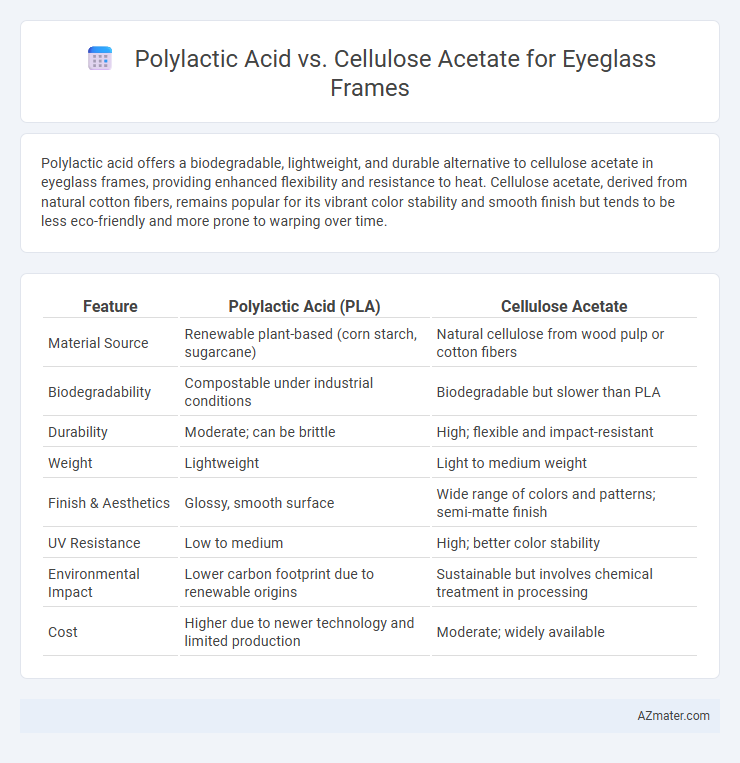Polylactic acid offers a biodegradable, lightweight, and durable alternative to cellulose acetate in eyeglass frames, providing enhanced flexibility and resistance to heat. Cellulose acetate, derived from natural cotton fibers, remains popular for its vibrant color stability and smooth finish but tends to be less eco-friendly and more prone to warping over time.
Table of Comparison
| Feature | Polylactic Acid (PLA) | Cellulose Acetate |
|---|---|---|
| Material Source | Renewable plant-based (corn starch, sugarcane) | Natural cellulose from wood pulp or cotton fibers |
| Biodegradability | Compostable under industrial conditions | Biodegradable but slower than PLA |
| Durability | Moderate; can be brittle | High; flexible and impact-resistant |
| Weight | Lightweight | Light to medium weight |
| Finish & Aesthetics | Glossy, smooth surface | Wide range of colors and patterns; semi-matte finish |
| UV Resistance | Low to medium | High; better color stability |
| Environmental Impact | Lower carbon footprint due to renewable origins | Sustainable but involves chemical treatment in processing |
| Cost | Higher due to newer technology and limited production | Moderate; widely available |
Introduction to Bioplastics in Eyewear
Polylactic acid (PLA) and cellulose acetate represent two leading bioplastic materials reshaping sustainable eyewear manufacturing, offering eco-friendly alternatives to conventional plastics. PLA, derived from renewable resources like corn starch, provides biodegradability and transparency, while cellulose acetate, made from plant-based cellulose, delivers durability with natural gloss and flexibility. Both materials support the growing demand for environmentally conscious eyewear, aligning with trends toward renewable raw materials and reduced carbon footprints in the fashion and accessories industry.
What is Polylactic Acid (PLA)?
Polylactic Acid (PLA) is a biodegradable thermoplastic derived from renewable resources like corn starch or sugarcane, commonly used in eco-friendly eyeglass frames due to its sustainability and lightweight properties. PLA offers excellent transparency, flexibility, and tensile strength, making it a viable alternative to traditional plastics in eyewear manufacturing. Unlike cellulose acetate, PLA has a lower environmental impact during production and disposal, enhancing its appeal for sustainable and biodegradable eyeglass frames.
Understanding Cellulose Acetate
Cellulose acetate is a plant-based biopolymer derived from wood pulp or cotton fibers, widely used in eyeglass frames due to its lightweight, hypoallergenic properties, and high tensile strength. Unlike polylactic acid, cellulose acetate offers superior flexibility and can be easily colored and textured, providing a broad range of stylish and durable eyewear options. Its biodegradability under composting conditions makes cellulose acetate a more environmentally friendly choice compared to many petroleum-based plastics.
Material Origins and Sustainability
Polylactic acid (PLA) is a bioplastic derived from renewable resources like corn starch or sugarcane, offering biodegradability and a lower carbon footprint compared to petroleum-based plastics. Cellulose acetate, sourced from cellulose extracted from cotton or wood pulp, is partially biodegradable and renewable but may involve chemical processing that impacts its overall sustainability profile. Both materials prioritize eco-friendly alternatives for eyeglass frames, with PLA emphasizing compostability and cellulose acetate balancing durability with renewable plant-based origins.
Strength and Durability Comparison
Polylactic acid (PLA) offers moderate strength and biodegradability but lacks the long-term durability needed for eyeglass frames, often becoming brittle under stress. Cellulose acetate, a plant-based polymer, provides superior impact resistance and flexibility, making it more durable and better suited for everyday wear and tear. The enhanced toughness and resistance to environmental factors make cellulose acetate the preferred choice for high-quality eyeglass frames focused on reliability.
Comfort and Wearability Factors
Polylactic acid (PLA) eyeglass frames offer lightweight durability and hypoallergenic properties, enhancing comfort during extended wear by reducing skin irritation and pressure points. Cellulose acetate frames provide superior flexibility and a smooth finish, improving wearability through better fit adjustment and breathability. Both materials excel in comfort, but PLA stands out for eco-friendly benefits while acetate offers customizable aesthetics and resilience.
Aesthetic Versatility and Design Options
Polylactic acid (PLA) offers superior aesthetic versatility for eyeglass frames due to its ability to be easily molded into diverse shapes and infused with vibrant, customizable colors and patterns. Cellulose acetate provides a classic, natural finish with a wide range of translucent and opaque options, but has more limitations in achieving intricate or highly varied designs compared to PLA. Designers often prefer PLA for innovative, contemporary frame styles, while cellulose acetate remains favored for traditional, high-end aesthetics.
Environmental Impact and Biodegradability
Polylactic acid (PLA) eyeglass frames offer superior biodegradability, breaking down into non-toxic components under industrial composting conditions within months, whereas cellulose acetate, derived from natural cellulose but chemically modified, decomposes more slowly and often requires specific environments to biodegrade effectively. PLA is produced from renewable resources like corn starch or sugarcane, resulting in a lower carbon footprint compared to cellulose acetate, which involves chemical acetylation processes that can generate harmful byproducts. Both materials reduce reliance on petroleum-based plastics, but PLA's compostability and reduced environmental toxicity make it a more sustainable choice for eco-friendly eyewear.
Cost Analysis and Market Trends
Polylactic acid (PLA) eyeglass frames generally incur higher production costs compared to cellulose acetate due to more complex manufacturing processes and raw material expenses, but PLA's biodegradability appeals to eco-conscious consumers, driving niche market growth. Cellulose acetate remains the dominant material in eyewear, benefiting from established supply chains and lower production costs, which sustain its strong market presence despite environmental concerns. Recent market trends indicate increasing investment in PLA technology and consumer demand for sustainable eyewear, suggesting a gradual shift towards PLA frames as cost efficiencies improve.
Which Material is Best for Eyeglass Frames?
Polylactic acid (PLA) offers excellent biodegradability and a lower environmental footprint compared to traditional plastics, making it a sustainable choice for eyeglass frames. Cellulose acetate provides superior flexibility, durability, and a classic aesthetic, widely preferred in premium eyewear for its comfort and resistance to wear. For those prioritizing environmental impact, PLA is best, whereas cellulose acetate excels in long-term durability and style.

Infographic: Polylactic acid vs Cellulose acetate for Eyeglass Frame
 azmater.com
azmater.com